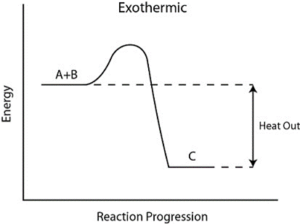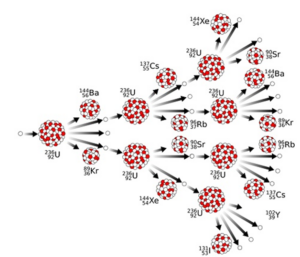In this article, “exothermic reaction examples”, different types of examples and some numerical problems with solutions on exothermic reaction are discussed briefly.
The examples are-
- Combustion Reaction
- Neutralization Reaction
- Corrosion Reaction
- Crystallization of Sodium Acetate or “Hot Ice”
- Making of an Ice Cube
- Nuclear Fission of Uranium (U-235)
- Respiration
- Formation of Ion Pairs
- Reaction between Water and Calcium Chloride
- Thermite Reaction
- Decomposition of Vegetables into Compost
- Solution of Sulfuric Acid and Water
What is an Exothermic Reaction?
Exothermic reaction is defined in thermodynamics as one type of reaction in which energy is released in form of heat (sometimes in form of light, sound or electricity) from system to surroundings.
For an exothermic reaction change of enthalpy (ΔH) is negative (less than zero).

Image Credit: Wikimedia Commons
To know more please follow : N2 polar or nonpolar: Why, How, Characteristics, And Detailed Facts
Combustion Reaction
Combustion reaction is a well known example of high temperature exothermic reaction. Combustion is basically a redox chemical reaction in which any compound is getting oxidized in presence of atmospheric oxygen and most of the times oxidized gaseous products are obtained.
Balanced equation of methane combustion is written below-
CH4 + 2O2 = CO2 + 2H2O
Neutralization Reaction
Neutralization reaction is one type of reaction in which acid gets neutralized by adding base in dropwise manner. So, this is one type of titration. After neutralization, no excess H+ or OH– ion remain unreacted in reaction medium.
For a neutralization reaction, change of enthalpy (ΔH) is always negative.
HCl+ NaOH = NaCl+ H2O
To know more please go through: Is HBr Ionic or Covalent : Why? How, Characteristics and Detailed Facts
Corrosion Reaction
Corrosion is one type of oxidation reaction in which a gas containing oxygen (air) attacks at the surface of a metal to form an oxide.
Rusting of iron is one type of corrosion reaction because during rusting iron metal is oxidized by atmospheric oxygen in normal temperature in presence of moisture.
4Fe + 3O2 +2xH2O = 2Fe2O3.xH2O
Crystallization of Sodium Acetate or “Hot Ice”
Solid sodium acetate trihydrate is heater above 330 K and the three crystal water molecules get eliminated and the anhydrous crystal is dissolved in water. The crystal is completely dissolved at 352K. The heat of hydration of sodium acetate trihydrate (ΔHhyd) is above 40 kcal/mol, an endothermic process. Thus, the reverse process, crystallization is an exothermic process.
Making of an Ice Cube
Formation of ice from water is an example of phase change reaction. During this phase change some amount of energy in form of heat is released to surroundings. Water freezes below 273K and loses some amount of energy in form of heat to surroundings to form ice. If water at 273K freezes and form ice at the same temperature then the amount of energy is released is equal to the latent heat (80cal/g).
To know more please follow: Peptide Bond vs Disulfide Bond: Comparative Analysis and Facts
Nuclear Fission of Uranium (U-235)
Nuclear fission generates a large amount of energy as in nuclear fission mass is converted into energy according this law ΔE= Δm×c2. In the fission reaction is splitting of any atom’s nucleus into two small constituent atoms by attacking a neutron(0n1). It is also an example of chain reaction as in every step of nuclear fission neutron is generated and this newly generating neutron can attack another uranium nucleus.

Image Credit: Wikimedia Commons
Respiration
Aerobic and anaerobic respiration occurs in mitochondria in a cell and generates heat energy to help in different biological activities in living organism. So, in the list of exothermic reaction example respiration must be included. 38 ATP and 2 ATP releases per glucose molecule for aerobic and anaerobic respiration respectively. For aerobic respiration, almost 3000 KJ/mol energy is released when glucose (food stuff) is oxidized by oxygen.
C6H12O6 + 6O2 = 6CO2 + 6H2O+ Energy
Formation of Ion Pairs
Formation of ion pairs or ion association is defined as when two ions having opposite electrical charge come in contact with each other in a solution and form a distinct chemical entity. This positive and negative charged two ions comes in contact due to electrostatic force of attraction between them. In formation of this distinct ionic entity an amount of energy release and ΔH becomes negative.
To know more please check: Peptide bond formation: How, Why ,Where ,Exhaustive Facts around it
Reaction between Water and Calcium Chloride
Mixing of calcium chloride (CaCl2) with water results a huge amount of energy and thus an example of chemical exothermic reaction. Hydrochloric acid and calcium oxide are obtained as product.
CaCl2 + H2O = Ca(OH)2 + HCl
Thermite Reaction
Reaction of ferrous oxide with aluminum is called thermite reaction and the mixture of these two compounds is known as thermite. These two reactants must be in powder form. This reaction generally releases a large amount of energy with aluminum oxide, elemental iron and light.
Fe2O3 + 2Al = 2Fe + Al2O3
Decomposition of Vegetables into Compost
This decomposition is carried out by microbes and requires greater amount of energy for breaking the chemical bonds present in those vegetables. This reaction also proceeds through exothermic pathway.
Solution of Sulfuric Acid and Water
Sulfuric acid reacts with water instantly and it is a high exothermic reaction. That is why water is not poured in the beaker concentrated sulfuric acid, rather sulfuric acid is added slowly in water. After adding water into acid it will start boiling and temperature reaches in a very high value within a short time.
Different numerical problems on exothermic reaction are discussed below-
1.Consider the reaction of water formation. 2H2 (g) + O2 (g) = 2H2O (g). The bond dissociation energy of H-H bond O=O bond and O-H bond are 105 kcal/mol and 119 kcal/mol 110 kcal/mol respectively. Calculate the amount of energy absorbed and released and state it as exothermic or endothermic reaction.
Answer: The balanced equation of water formation is-
2H2 (g) + O2 (g) = 2H2O (g).
In reactant side total energy possessed by reactants =2 (H-H bond) + 1 (O=O bond) = {(2 ×105) + 119} kcal/mol = 329 kcal/mol
In product side total energy possessed by water molecule = 4(O-H bond)
= (4×110) kcal/mol = 440 kcal/mol Enthalpy change (ΔH) = bond broken enthalpy – bond formation enthalpy = (329-440) kcal/mol. = -111 kcal/mol
Thus it is an exothermic reaction (enthalpy change negative).
2. Calculate the released energy in the following nuclear fission reaction- 238U = 95Sr + 140 Xe + 3n.
The atomic mass of 238U= 238.050784 amu, 95Sr = 94.919388 amu, 140Xe = 139.921610 amu and mass of neutron (0n1) = 1.008665 amu.
Answer: Mass of the products = {94.919388 + 139.921610 + (3×1.008665)} amu = 237.866993 amu. Mass of the reactant = 238.050784 amu Mass defect = (238.050784 – 237.866993) amu = 0.183791 amu. Energy released due to mass defect = Δm×c2 = 171.20 MeV.
3.Calculate del H for the reaction- 2NO2 (g) = N2 (g) + 2O2 (g)
The enthalpy changes for the reaction given below-
2NO (g) = N2 (g) + O2 (g) ΔH = -180.5 KJ NO2 (g) = NO (g) + (1/2) O2 ΔH = 57.06 KJ
Answer: 2NO (g) = N2 (g) + O2 (g) (2nd reaction× 2) NO2 (g) = NO (g) + (1/2) O2
Resultant equation will be = 2NO2 (g) = N2 (g) + 2O2 (g) Thus, enthalpy change of this reaction is (ΔH) = {-180.5 + (2×57.06)} KJ = -66.38 KJ.
Frequently Asked Questions (FAQ)
How can the rate of an exothermic reaction be increased?
Answer: Exothermic or endothermic reaction depends on temperature. If temperature of the reaction medium is increased then the extent of exothermic reaction will be increased.
What is the difference between an exothermic and an endothermic reaction?
| Endothermic Reaction | Exothermic Reaction |
| Endothermic reaction absorbs energy | Exothermic reaction releases energy. |
| Change of enthalpy (ΔH) is positive. | Change of enthalpy (ΔH) is negative. |
| Decreasing of temperature increases the rate of the reaction | Increasing of temperature favors the forward reaction. |
What is the change of entropy for an exothermic reaction?
Answer: For an exothermic reaction entropy of surroundings always increases as energy is released from system to surroundings.
Also Read:
- Compound pulley examples
- Elastic force examples
- Photoautotrophic bacteria examples
- Examples of displacement
- Centripetal force examples definition faq
- Hydrogen bond examples
- Metathesis reaction examples
- Condensation examples
- Alkyl halide examples
- Conservative force examples

Hello,
I am Aditi Ray, a chemistry SME on this platform. I have completed graduation in Chemistry from the University of Calcutta and post graduation from Techno India University with a specialization in Inorganic Chemistry. I am very happy to be a part of the Lambdageeks family and I would like to explain the subject in a simplistic way.
Let’s connect through LinkedIn-https://www.linkedin.com/in/aditi-ray-a7a946202